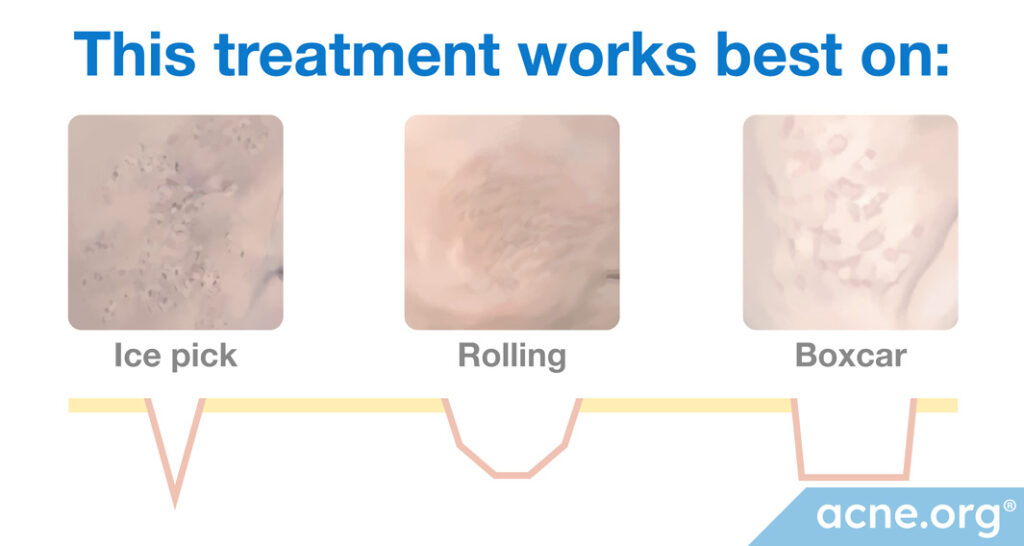
* Light / Superficial Chemical Peels are unlikely to provide noticeable results for acne scarring. However, for people with active acne and extremely shallow scarring, it may be an interesting option.
A chemical peel is a mixture of chemicals applied to the skin to strip away the top layers of the skin. The goal is to cause a controlled injury and trigger the body’s natural healing process. As the skin rebuilds, it will produce more collagen and elastin (proteins naturally found in the deeper layers of the skin), which should improve the appearance of acne scars once healing is completed.1
Chemical peels differ in how deep they penetrate into the skin. Stronger peels penetrate deeper into the skin and can provide better results, but also carry a higher risk of side effects.1 Chemical peels fall into three types based on how deep they penetrate into the skin.
Light / Superficial peels only remove part of the outer layer of the skin, called the epidermis, and thus can only treat very superficial scars.
When it comes to treating acne scars, light peels are not very effective. In general, medium-depth or deep peels are necessary to see significant improvement in the appearance of scars.
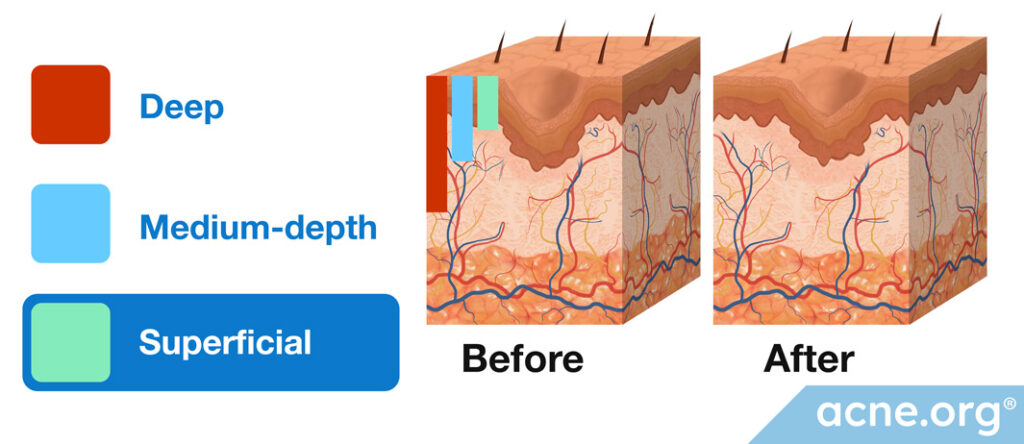
With light and medium-depth peels, multiple (3-6) treatments spaced out at intervals of 2-3 weeks are often necessary to achieve the desired effect.3-6
As with all scar revision treatments, chemical peels are sometimes combined with other scar revision procedures to achieve desired results.
Unlike other acne scar treatments, light/superficial chemical peels can be used for acne treatment as well. If you are experiencing active acne lesions with very superficial post-acne scaring, you might benefit from light/superficial peels.
Before agreeing to undergo treatment with a chemical peel, ask multiple doctors about their opinions, proposed treatments, expected outcomes, and prices.
Procedure details:
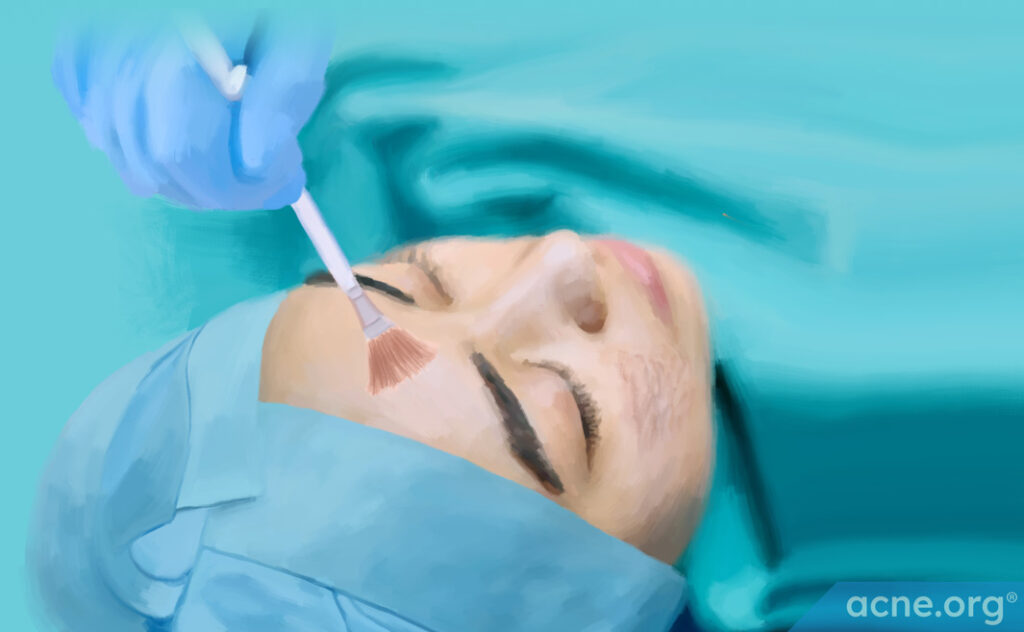
The chemicals used in chemical peels are usually different types of acids, which corrode (eat away at) the skin when they are applied to the skin surface. For light peels, doctors use weak acids or low concentrations of strong acids. For deeper peels, stronger acids and/or higher concentrations of acids are used.
Light / Superficial peels contain one of the following chemicals:1,2,9
- TCA (trichloroacetic acid) in low concentrations from 10% to 15%*
- Alpha-hydroxy acids (AHA) such as:
- Glycolic acid in various concentrations
- Lactic acid in various concentrations
- Mandelic acid in various concentrations
- Beta-hydroxy acids (BHA) such as:
- Salicylic acid in various concentrations
- Jessner’s solution, consisting of 14% lactic acid, 14% salicylic acid, and 14% resorcinol or citric acid in 95% ethanol (drinking alcohol).
* TCA (trichloroacetic acid) is the “gold standard” of chemical peel treatments–in other words, it is the most common and most frequently recommended chemical peel for acne scars. This is because, if applied correctly, a TCA peel provides the best balance of high efficacy and relatively low side effects. TCA can act as a light, medium-depth, or deep peel depending on the concentration: the higher the concentration, the deeper the peel. After the application of a TCA peel, a characteristic white “frost” appears on the skin.9 Today, TCA is often applied using a new technique called CROSS (Chemical Reconstruction Of Skin Scars).
Anesthesia:
Light / Superficial peels do not require anesthesia or sedation and are simply applied directly to the skin with no numbing. Most patients experience some burning and/or stinging, but the discomfort is short-lived and tolerable.3,6,11
Before-and-after:
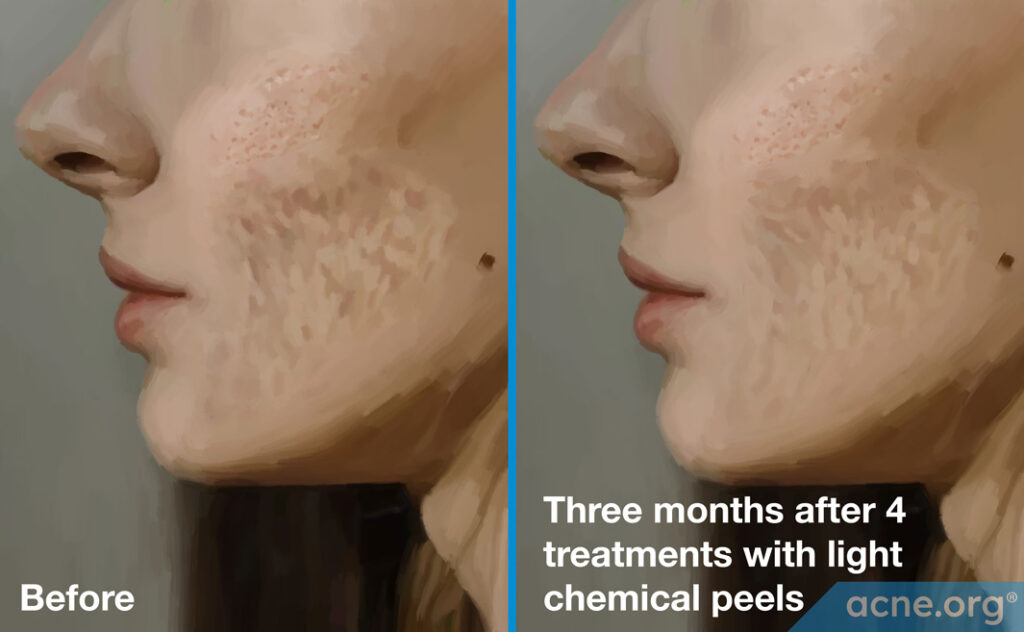
Acne scars before (left) and 3 months after (right) 4 treatments with light chemical peels.
References
- Levy LL, and Zeichner JA. Management of acne scarring, part II. A comparative review of non-laser-based, minimally invasive approaches. Am J Clin Dermatol. 13(5), 331-340 (2012).
- Landau M. Chemical peels. Clin Dermatol. 26(2), 200-8 (2008).
- Garg VK, Sinha S, and Sarkar R. Glycolic acid peels versus salicylic-mandelic acid peels in active acne vulgaris and post-acne scarring and hyperpigmentation: a comparative study. Dermatol Surg. 35(1), 59-65 (2009).
- Puri N. Efficacy of Modified Jessner’s Peel and 20% TCA Versus 20% TCA Peel Alone for the Treatment of Acne Scars. J Cutan Aesthet Surg. 8(1), 42-5 (2015).
- Al-Waiz MM, and Al-Sharqi A. Medium-depth chemical peels in the treatment of acne scars in dark-skinned individuals. Dermatol Surg. 28(5), 383-7 (2002).
- Sachdeva S. Lactic acid peeling in superficial acne scarring in Indian skin. J Cosmet Dermatol. 9(3), 246-8 (2010).
- Leheta TM, Abdel Hay RM, and El Garem YF. Deep peeling using phenol versus percutaneous collagen induction combined with trichloroacetic acid 20% in atrophic post-acne scars; a randomized controlled trial. J Dermatolog Treat. 25(2), 130-6 (2014).
- Park JH, Choi YD, Kim SW, Kim YC, and Park SW. Effectiveness of modified phenol peel (Exoderm) on facial wrinkles, acne scars and other skin problems of Asian patients. J Dermatol. 34(1), 17-24 (2007)
- Kontochristopoulos G, and Platsidaki E. Chemical peels in active acne and acne scars. Clin Dermatol. 35(2), 179-182 (2017).
- Brody HJ. Complications of chemical peeling. J Dermatol Surg Oncol. 15(9), 1010-1019 (1989).
- Erbağci Z, and Akçali C. Biweekly serial glycolic acid peels vs. long-term daily use of topical low-strength glycolic acid in the treatment of atrophic acne scars. Int J Dermatol. 39(10), 789-94 (2000).
- Mackee GM, and Karp FL. The treatment of post-acne scars with phenol. Br J Dermatol. 64(12), 456-9 (1952).
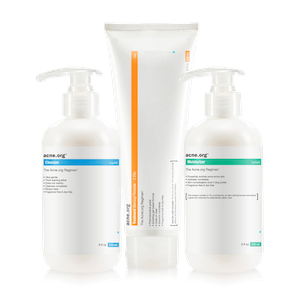 Acne.org Products
Acne.org Products